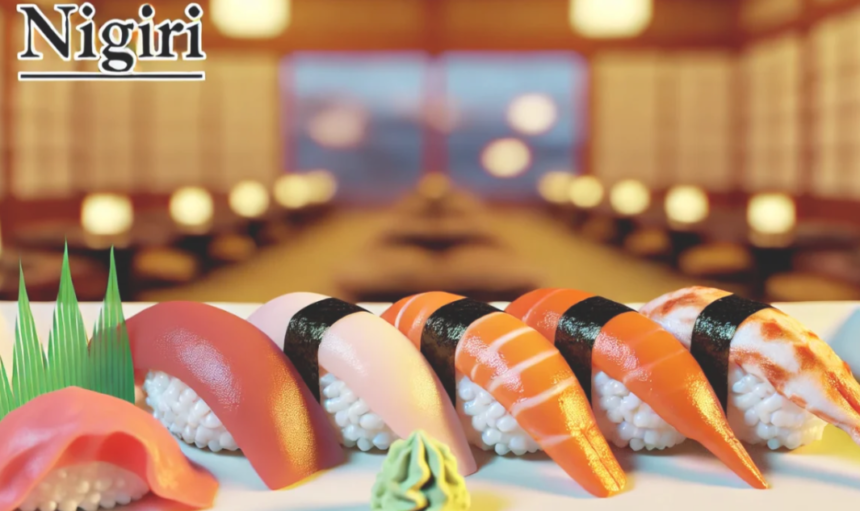Nigiri sushi is one of the most popular and beloved forms of sushi around the world. Its simple yet elegant presentation makes it a favorite among sushi lovers. In this blog post, we will explore everything you need to know about this sushi, from its origins and types to how it’s made and enjoyed. Let’s dive into the world of this delightful Japanese dish.
What is Nigiri Sushi?
It is a traditional Japanese sushi style that consists of a small mound of vinegared rice topped with a slice of fresh fish or other seafood. The term “nigiri” comes from the Japanese word “nigiru,” which means “to grasp” or “to mold,” referring to how the rice is shaped by hand. This sushi is known for its fresh ingredients and the skill involved in preparing it.
The Components of Nigiri
To understand it , it’s important to know its main components:
- Sushi Rice: The foundation of it is the sushi rice, known as shari. This rice is seasoned with a mixture of vinegar, sugar, and salt, giving it a slightly tangy flavor.
- Toppings: The toppings can vary widely, including:
- Fish: Common choices include tuna, salmon, and eel.
- Shellfish: Shrimp and scallops are also popular.
- Vegetables: Sometimes, vegetables like avocado or cucumber may be used as toppings.
- Wasabi: Often, a small amount of wasabi is placed between the rice and the topping to enhance flavor.
- Soy Sauce: it is typically enjoyed with soy sauce for dipping, adding another layer of flavor.
A Brief History of This Sushi
This sushi originated in the early 19th century in Edo (modern-day Tokyo). It started as a form of fast food known as “edomae-zushi,” which means “Edo-style sushi.” Street vendors would prepare it sushi on the spot, allowing customers to enjoy it quickly.
In those days, the fish was often pickled or preserved to ensure freshness. Over time, as transportation and refrigeration improved, sushi chefs began to use fresher ingredients. Today, this sushi is enjoyed worldwide, with various regional variations.
Types of Nigiri Sushi
There are several types of this sushi, each distinguished by its topping and preparation method. Here are some of the most common types:
-
Maguro Nigiri
Maguro, or tuna, is one of the most popular toppings for this sushi. It comes in several varieties, including:
- Akami: The leaner, red part of the tuna.
- Toro: The fatty belly portion, known for its rich flavor and buttery texture.
-
Sake Nigiri
Sake, or salmon, is another favorite topping. Its vibrant color and rich flavor make it a staple in sushi restaurants. It is often enjoyed both raw and grilled.
-
Ebi Nigiri
Ebi refers to shrimp. For nigiri, ebi is usually boiled and served on top of the rice. It has a sweet flavor and a firm texture.
-
Unagi Nigiri
Unagi, or grilled eel, is a popular choice for this as well. It is typically glazed with a sweet soy sauce and has a distinct smoky flavor.
-
Ikura Nigiri
Ikura, or salmon roe, is another unique topping for this. The small, translucent eggs burst with flavor and add a pop of color to the dish.
How to Make this Sushi at Home?
Making this sushi at home can be a rewarding experience. Here’s a simple step-by-step guide:
Ingredients Needed
- Sushi Rice: 2 cups
- Rice Vinegar: 1/3 cup
- Sugar: 2 tablespoons
- Salt: 1 teaspoon
- Fresh Fish: Choose your favorite, such as tuna or salmon.
- Wasabi: Optional, for added flavor.
- Soy Sauce: For serving.
Step-by-Step Instructions
-
Prepare the Sushi Rice:
- Rinse the sushi rice under cold water until the water runs clear.
- Cook the rice according to the package instructions.
- In a small saucepan, heat the rice vinegar, sugar, and salt until dissolved. Pour this mixture over the cooked rice and gently mix to combine.
-
Shape the Rice:
- Once the rice has cooled, wet your hands to prevent sticking.
- Take a small amount of rice (about a tablespoon) and mold it into an oval shape with your hands.
-
Prepare the Fish:
- Slice your chosen fish into thin pieces (about 1/4 inch thick).
- If using wasabi, place a small dab on the rice.
-
Assemble the Nigiri:
- Place a slice of fish on top of each rice mound.
- Press gently to adhere the fish to the rice.
-
Serve:
Arrange this on a plate and serve with soy sauce for dipping.
Enjoying Sushi
This sushi is best enjoyed fresh. Here are some tips on how to savor it:
- Dipping: Dip the fish side of this into soy sauce to avoid soaking the rice, which can become mushy.
- Pairing: Enjoy with pickled ginger, which helps cleanse the palate between bites.
- Beverages: this pairs well with sake, green tea, or even a light beer.
Nutritional Benefits
This sushi offers several nutritional benefits:
- Protein: Fish is an excellent source of high-quality protein.
- Omega-3 Fatty Acids: Many fish, like salmon, are rich in omega-3s, which are beneficial for heart health.
- Low in Calories: When prepared without excess sauces, this can be a low-calorie meal option.
Conclusion
Nigiri sushi is more than just a meal; it is a culinary art form that reflects the rich traditions of Japanese cuisine. With its simple ingredients and elegant presentation, this offers a delightful experience for sushi enthusiasts. Whether enjoyed in a restaurant or made at home, this remains a timeless dish that continues to captivate taste buds around the world.
FAQs
What is the difference between nigiri and sushi?
this is a specific type of sushi made with a mound of rice topped with fish. Sushi can refer to a variety of dishes, including rolls and sashimi.
Can I make this with cooked fish?
Yes, this can be made with both raw and cooked fish, such as shrimp or eel.
Is this sushi gluten-free?
The sushi rice is gluten-free, but soy sauce often contains gluten. Look for gluten-free soy sauce if necessary.
How long does this sushi last?
This is best eaten fresh but can be stored in the refrigerator for a day. However, the rice may become hard.
What kind of fish is best for this?
Popular choices include tuna, salmon, and eel, but you can use any fresh seafood you enjoy.
Can vegetarians eat this?
Yes, there are vegetarian options available, such as this topped with avocado or cucumber.
How is this different from sashimi?
This consists of sushi rice topped with fish, while sashimi is simply slices of raw fish served without rice.







